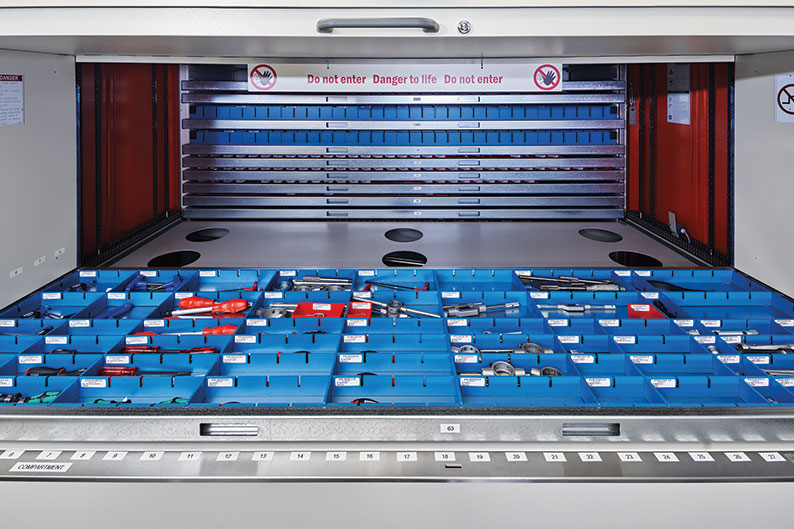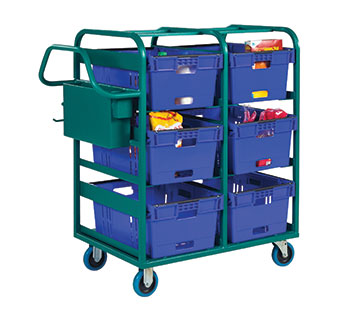Totes, bins and containers: Uncontainable opportunity?
Totes, bins and containers didn’t avoid the coronavirus effect, but the segment adjusts and firmly looks ahead.

The coronavirus has taken its toll on most industries, including in the area of totes, bins and containers. But shipments still need to go out to businesses and the public still needs them to get there.
It’s been a year that’s seen growing e-commerce and a larger focus on cleanliness. But for totes, bins and containers, 2020 has also seen a continuation of trends that began years ago. Let’s take a look at where the segment is and where it’s going. After all, so much of this sector is about movement.
Give me an “E”
Ken Beckerman, president at Flexcon, saw e-commerce stuck in March much like how so many saw this faction of potential opportunity. But, he says, it’s clearly shifted. “People delayed their purchases and everyone was thrown for a loop, but waiting out the problem turned into a mad rush,” he says. “It required us to step up the ability to produce.”
This only brought automation more into the fray. “We are making a ton of totes designed to work with automation these days, but, remember, automation won’t be for everyone,” Beckerman says. “You have to see where it works for a company’s strategy and where it doesn’t.”
As an example, Flexcon is working with a major sneaker company that is buying thousands of stackable totes for automated systems, even though the company isn’t ready to automate now. Rather, it’s an investment in the future. “Even companies that have not automated yet are thinking about the future—and it’s something you need to strongly consider,” he says.
Andrea Nottestad, a marketing manager at ORBIS, believes automation is huge. “Automated systems have different requirements. Often, these are tighter tolerances and specifications so that totes interface seamlessly with the equipment. I think e-commerce and automation are the two biggest influences on handhelds and totes.”
In addition to automation, end users continue to demand lightweight totes and containers. That is especially true in manual operations, where associates are lugging around equipment and totes that can lead to injuries. “You need to be more efficient, and we have found no-break formulations of resins can be bought that keep it light but are still strong,” says Beckerman.
Lighter totes still need to be effective, Nottestad reminds. “The tote still needs to serve a purpose, and you’re just always balancing that,” she says.
Beckerman believes it’s important not to overlook small victories, as even an area like adjustable dividers could become a bigger player when some aren’t looking. “In the world of vertical lifts, for example, it’s huge,” he says. “Think about the size of the tray and how much organizing that it can require. In 2019, we did over 10,000 trays’ worth and we’re tracking this year for about the same. And, consider the year. When you see it hasn’t shrunk because of Covid then you see it has a chance to get that much bigger next year.”
State of RFID
When you consider innovation and a step forward, RFID was supposed to be a magic bullet when it came to visibility and inventory management. Though radio frequency identification is far from dead, it has cooled in the minds of some.
Craig Heil, container sales manager at Steel King, thought years ago from its buzz that RFID tags would be on practically every product today. Not so. “When RFID first gained popularity during the Walmart mandate, we thought you would see requests constantly for it on all different things we manufacture with containers and portables,” Heil says. “But let’s be honest—it never turned into what it was supposed to be. Does that mean it won’t?” He adds that we may see more requests with European companies, since generally, they are willing to spend more on technology with a longer ROI than their North American counterparts.
Leslie LeMair, vice president of sales for Georg Utz, targets 2016 to 2019 as when RFID was making the most progress and believes maybe the pandemic just took it off its run and that it will later get back on track. “There are many who appreciate being able to tell you your product is shipped out the door,” LeMair says. “It doesn’t solve every problem, but I think what will happen with retailers setting up for delivery that you will see more orders scanned for delivery and then we will see it be revisited more.”
Nottestad believes RFID continues to be part of the discussion, but the potential applications where customers believe the technology can deliver value is narrowing. “RFID is not a magic bullet, but many believe it will play a role in the future,” she says. “But, end users are still vetting the technology and could be jumping to alternative technologies, such as GPS, since it has more line of sight visibility and a real-time aspect.”
Preparing for an ongoing issue
Given the fixation on repeated cleaning after use, you might have thought end users would be shunning reusable containers in favor of one-time use products. That doesn’t appear to be the case. “We just sell and sell multiple-use totes, regardless of what’s happened with Covid,” Beckerman says. “I think that companies are conscious of cleaning, with many focused on how to deal with the situation rather than taking a step backward to one-time use containers. They don’t want to undo the benefits they’ve gained from multi-use containers.”
 LeMair believes the retail segment is going through an evolution and rethinking in some ways from the coronavirus leading to an adjustment and the utilization of bins, containers and totes, like every other part of the supply chain.
LeMair believes the retail segment is going through an evolution and rethinking in some ways from the coronavirus leading to an adjustment and the utilization of bins, containers and totes, like every other part of the supply chain.
“Because you don’t have as many shoppers inside the store, then you’re seeing basket size diminishment and retailers will have to get more productive and it and will forever change how retailers look,” LeMair says. “The whole process needs to accept that the model will become more prevalent where shoppers will place their orders, walk up to store and get what they want and adjust the numbers in their mind and their way of thinking. How can they efficiently ship on the back end in a shifting environment? There are questions still left to be worked out, but you can’t just think everything will go back to the way it was when the situation with the coronavirus changes over time.”
While concern for a recurrence of a coronavirus has to stay on people’s minds, as they get more used to adjustments there may be room to get back to that truly optimistic mindset for the segment.
“I think we have to keep inventory levels high and need to be prepared for continued improvement and opportunity,” Beckerman says. “As the push continues…lead time to be competitive just becomes crucial.”
Companies mentioned in this article

Article Topics
Containers & Totes News & Resources
K.Hartwall and its Australian distribution partner, Retailquip, join forces Flexcon unveils its innovative bin solutions Packaging Corner: Be open to change ORBIS expands manufacturing plant in Urbana, Ohio Tuggers, carts & casters work in harmony to fill the labor gap ORBIS hosts third annual golf outing to benefit Children’s Wisconsin Flexcon showcases variety of containers to support automation More Containers & TotesLatest in Materials Handling
Registration open for Pack Expo International 2024 Walmart chooses Swisslog AS/RS and software for third milk processing facility NetLogistik partners with Vuzix subsidiary Moviynt to offer mobility solutions for warehouses Materials Handling Robotics: The new world of heterogeneous robotic integration BSLBATT is looking for new distributors and resellers worldwide Lucas Watson appointed CSO for Körber’s Parcel Logistics business in North America Hyster recognizes Dealers of Distinction for 2023 More Materials HandlingSubscribe to Materials Handling Magazine

Find out what the world's most innovative companies are doing to improve productivity in their plants and distribution centers.
Start your FREE subscription today.
April 2024 Modern Materials Handling

Latest Resources










